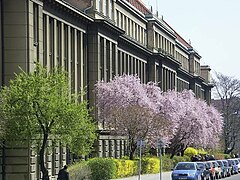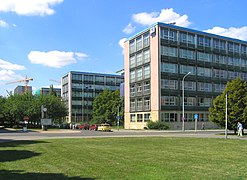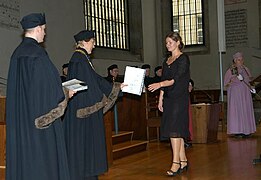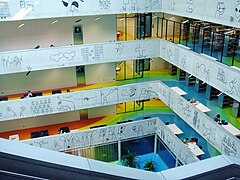Czech Technical University in Prague
České vysoké učení technické v Praze | |
 | |
| Motto | Scientia est potentia (Latin) |
|---|---|
Motto in English | Knowledge is power |
| Type | Public |
| Established | 1707 by the Kingdom of Bohemia |
| Affiliation | PEGASUS CESAER |
| Rector | Vojtěch Petráček |
Administrative staff | 1,786 (2019) |
| Students | 17,229 (2019) |
| Location | Prague , Czech Republic 50°6′7.8″N 14°23′18.5″E / 50.102167°N 14.388472°ECoordinates: 50°6′7.8″N 14°23′18.5″E / 50.102167°N 14.388472°E |
| Website | www |

Czech Technical University in Prague (CTU, Czech: České vysoké učení technické v Praze, ČVUT) is one of the largest universities in the Czech Republic with 8 faculties, and is one of the oldest institutes of technology in Central Europe. It is also the oldest non-military technical university in Europe.[1]
In the academic year 2020/21 Czech Technical University offered 130 degree programs in Czech and 84 in English. It was considered one of the top 10 universities in emerging Europe and Central Asia in the same year.[2]
History[]

It was established as the Institute of Engineering Education in 1707, but as a secondary education (high school) instead of a tertiary university, by Emperor Joseph I[3] as a response to Christian Josef Willenberg's petition addressed to preceding emperor Leopold I. In 1806 the institute of Engineering Education was transformed into Prague Polytechnical Institute (or Prague Polytechnic), when the university studies began. After the disintegration of the Austro-Hungarian Empire, the name of the school was changed in 1920 to the Czech Technical University in Prague.
Origins[]
In 1705, asked Emperor Leopold I for permission to teach "the art of engineering". Later, the emperor's only son, who succeeded him on the throne in 1707 as Joseph I, ordered the Czech state of Prague to provide engineering education. Due to various reasons the request was avoided long periods of time but in October 1716 Willenberg repeated the request and finally on 9 November 1717 a decree by the Czech state granted Willenberg the professorship (first engineering professorship in Central Europe) and on 7 January 1718 he began teaching. Initially, Willenberg started teaching only 12 students in his own apartment (six barons , four knights and two burghers), but gradually students proliferated (in 1779 there were around 200) and they started studying in more suitable premises. Initially, the training focused mainly on the military. Teaching in the first year lasted one hour per day in the second year almost two.
The successor of prof. Willenberg was , builder of hydraulic structures in the basin of the Vltava and author of textbooks used at the school of mathematics. He began under Willenberg's leadership by teaching optics, perspectivity, technical drawing and geography. The third was professor , who mainly focused on civil engineering, particularly construction.
In September 1776 Maria Theresa allowed Herget to use the Clementinum building; in 1786 the school moved to the new and better building.
In 1787 the School of Engineering was established at the decree of Emperor Joseph II.
Academic profile[]
| University rankings | |
|---|---|
| Global – Overall | |
| ARWU World[4] | 601-700 |
| CWTS World[5] | 799 |
| QS World[6] | 531-540 |
| THE World[7] | 601-800 |
| USNWR Global[8] | 410 |
| National – Overall | |
| ARWU National[4] | 3 |
| QS National[6] | 2 |
| THE National[7] | 3 |
Rankings[]
The CTU is the best technical university in the Czech Republic. In 2010, in the world rating of THES-QS universities in the category of technical sciences, the CTU took the 121st place, in the category of natural sciences – 246th place.[9] In 2018 Czech Technical University was ranked as 220th in Engineering and Technology in the QS World University Rankings.[10]
Admissions[]
Students apply to faculty. Each faculty has different admissions requirements. Acceptance rate ranges from 52.32% (Faculty of Information Technology) to 81.51% (Faculty of Transportation Sciences).[11] The percentage of international students grew from 2.5% in 2000 to 16.4% in 2017.[12][13]
Graduation rate[]
Due to the pace and difficulty of CTU coursework, high percentage of students fail to complete first year of their studies. First year failure rates range from 23% (Faculty of Civil Engineering) to 47% (Faculty of Information Technology).[14] Overall, only 48% of enrolled undergraduate students end up graduating.[citation needed]
International cooperation[]
Study and work abroad[]
CTU has international agreements with 484 foreign universities. Many of them are ranked in the first hundred in QS World University Rankings such as National University of Singapore, Nanyang Technological University, Purdue University, Korea Institute of Science and Technology (KAIST), Hong Kong University of Science and Technology, Technical University of Munich, Delft University of Technology or KU Leuven.
CTU has many bilateral agreements with universities outside of Europe. The most sought after universities are from Canada, Australia, Singapore, United States and Japan. That said, every year many students choose to study in attractive destinations such as Argentina, Brazil, China, Hong Kong, India, Indonesia, South Africa, South Korea, Costa Rica, Mexico, New Zealand, Peru, Russia or Taiwan.
CTU also participates in the European programmes Erasmus and Leonardo.[9]
International students[]
CTU has currently over 3500 international students from 117 countries. About 750 of them are an exchange students. One of the organizations that takes care of international students is International Student Club (ISC), which organizes Buddy Programme and extra-curricular activities.
Dual diploma[]
CTU has currently 21 agreements with universities such as Technical University of Munich, RWTH Aachen or Trinity College Dublin.
Constituent parts[]
| Faculty/school | Year founded |
| Civil Engineering | 1707 |
| Mechanical Engineering | 1864 |
| 1950 | |
| Nuclear Sciences and Physical Engineering | 1955 |
| Architecture | 1976 |
| MIAS School of Business | 1992 |
| Transportation Sciences | 1993 |
| Biomedical Engineering | 2005 |
| Information Technology | 2009 |
CTU has 8 faculties. The oldest one (Faculty of Civil Engineering) was founded in 1707, while the youngest and most selective faculty (Faculty of Information Technology) was founded in 2009.
The university also has 5 university institutes, such as Czech Institute of Informatics, Robotics and Cybernetics, Klokner Institute, Institute of Physical Education and Sport, University Centre for Energy Efficient Buildings and Institute of Experimental and Applied Physics.
Other constituent parts include Computing and Information Centre, Technology and Innovation Centre, The Research Centre for Industrial Heritage, Centre for Radiochemistry and Radiation Chemistry, Division of Construction and Investment and Central Library.
The university also has a Publishing House and service facilities.
Student clubs within the CTU are integrated in the . It has 27 members and covers a wide range of free time activities, with the biggest club being . The Student Union also organizes social events for students throughout the year.
Notable alumni[]
- František Běhounek, radiologist
- Christian Doppler, mathematician and physicist
- Ivan Puluj, physicist and one of the founders of medical radiology
- Antonín Engel, architect
- Josef Gerstner, physicist and engineer
- Václav Havel, statesman, writer and former dissident, who served as the last President of Czechoslovakia
- Josef Hlávka, architect, main founder of Academy of Science, patron
- Otakar Husák, CTU graduate, chemist, General, Czechoslovak Legionnaire in Russia and France, fighter from Zborov and Terron, Chairman of President Masaryk's Military Office, Minister of Defence, First Director of the Explosia Semtín factory, prisoner of concentration camps Dachau and Buchenwald, Director of the Synthesia Semtín (1945–1948), political prisoner (Prague Nusle-Pankrác, Mírov 1950–1956) [15]
- Eva Jiřičná, architect
- Karel Jonáš, who became Charles Jonas (Wisconsin politician), Czech-American publisher, legislator and Lieutenant Governor of Wisconsin
- George Klir, computer and systems scientist
- Karl Kořistka, geographer and technologist
- František Křižík, inventor, electrical engineer and entrepreneur
- Ivo Lukačovič, entrepreneur, founder and chairman of Seznam.cz
- Vladimir Prelog, chemist and Nobel Prize winner
- Richard Rychtarik, set designer
- Emil Votoček, chemist
- Emil Weyr, mathematician
- Josef Zítek, architect and engineer
Gallery[]

The CTU Rectorate

Dejvice campus

Karlovo Náměstí campus

Bethlehem Chapel – The CTU's ceremonial hall

Dejvice campus - Library, FA, FIT

Interior of National Technical Library
Notes and references[]
- ^ Czech Technical University In Prague - Topuniversities
- ^ Czech Technical University In Prague - Topuniversities
- ^ "Rescript of the Emperor Joseph I". Archived from the original on 2009-10-05.
- ^ Jump up to: a b "ARWU World University Rankings 2018 | Academic Ranking of World Universities 2018 | Top 500 universities | Shanghai Ranking - 2018". www.shanghairanking.com.
- ^ Studies (CWTS), Centre for Science and Technology. "CWTS Leiden Ranking". CWTS Leiden Ranking.
- ^ Jump up to: a b "QS World University Rankings 2019". Top Universities. February 1, 2017.
- ^ Jump up to: a b "World University Rankings". Times Higher Education (THE). August 18, 2017.
- ^ "Ranking". www.usnews.com. Retrieved 2020-01-26.
- ^ Jump up to: a b "Czech Technical University (CTU)". msmstudy.eu. Archived from the original on August 29, 2018.
- ^ "QS Engineering and Technology ranking". topuniversities.com.
- ^ "Acceptance rate of Czech Universities". vysokeskoly.com (in Czech).
- ^ "Annual report 2000" [Czech] (PDF). cvut.cz (in Czech). Archived from the original (PDF) on October 21, 2018.
- ^ "Annual report 2017" (PDF). cvut.cz (in Czech). Archived from the original (PDF) on October 21, 2018.
- ^ "Annual report 2017" (PDF). cvut.cz (in Czech). p. 77. Archived from the original (PDF) on October 21, 2018.
- ^ (CS) PRECLÍK Vratislav. Masaryk a legie (Masaryk and Legions, Масарик и Легии), Ваз. Книга, váz. kniha, 219 p., vydalo nakladatelství Paris Karviná, Žižkova 2379 (734 01 Karviná, CZ) ve spolupráci s Masarykovým demokratickým hnutím (изданная издательством «Пари Карвина», «Зишкова 2379» 734 01 Карвин, в сотрудничестве с демократическим движением Масаpика, Прага) , 2019, ISBN 978-80-87173-47-3, pp. 16 – 70, 150-157
External links[]
| Wikimedia Commons has media related to Czech Technical University. |
- CTU official website in English
- CTU official website in Czech
- www.StudyAtCTU.com Official website for international students
- International Student Club Organization for international students
- IAESTE Organization for international students
- UCEEB University Centre for Energy Efficient Buildings (UCEEB)
- Top Industrial Managers for Europe (TIME) network for student mobility.
- Czech Technical University in Prague
- Universities in the Czech Republic
- Technical universities and colleges
- Educational institutions in Prague
- 1707 establishments in the Holy Roman Empire
- 1707 establishments in the Habsburg Monarchy
- 18th-century establishments in Bohemia
- Educational institutions established in 1707
- Engineering universities and colleges in the Czech Republic








